Other Factors That Determine Diamond Cut Quality: Girdle Thickness, Culet Size, Symmetry and Polish
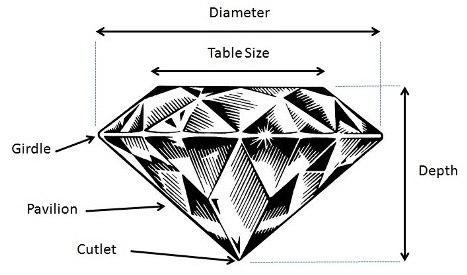
What other factors affect cut grade besides a diamond’s proportions?
Apart from the proportions (the most critical factor), there are 4 other factors that are taken into account when a gemological lab assesses the cut grade of a diamond.
They are the diamond’s girdle thickness, culet size, symmetry and polish. In this write up, we are going to take a deeper look into each of these factors and help you understand how they can affect a diamond’s appearance and cut quality.
Girdle Thickness – Why It Matters?
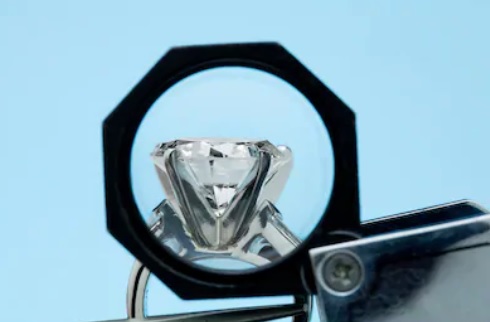
The girdle is the outermost surface of the diamond and its main purpose is to prevent chipping during the setting process. Depending on the shape of the diamond, the ideal girdle thickness can vary. In round diamonds, a thin-medium girdle thickness is preferred.
However, when it comes to fancy shapes, a girdle thickness of thin to very thick or extremely thick can be justifiable. This is especially true if the shape consists of sharp points which are vulnerable to damage. For example, the 4 corners of a princess cut are very susceptible to chipping and a thicker girdle thickness can ensure better durability.
In cut grading, the girdle thickness is taken into account because of 2 reasons:
1) A very thick girdle will result in a smaller looking diamond because the extra weight is hidden in the girdle area. Ideally, the girdle should be just thick enough to prevent chipping.
2) A very thin girdle subjects the stone to additional risks of chipping and causes it to be penalized for durability reasons. As a result, the overall cut grade will be downgraded.
In general, a diamond can have a girdle finishing which falls under one of the following:
Faceted – Cut and polished facets.
Polished – Clear or see through.
Unfaceted, or Bruted – Left in its original rough state.
The majority of diamonds you see in today’s market either have a faceted or polished girdle. Personally, I prefer either a faceted girdle as it gives the stone a more complete look. On top of that, it can help mask flaws found in the vicinity of the girdle. It is also interesting to note that the type of girdle finishing will have no impact on the diamond’s clarity or cut grade.
Presence of a Culet
The culet is the pointed tip where the pavilion mains meet. Sometimes, the culet is polished off and the sole purpose of doing this is to protect the tip from breaking or chipping.
If the culet is too large, it can look like a dark spot underneath the table and become very distracting to the diamond’s appearance.
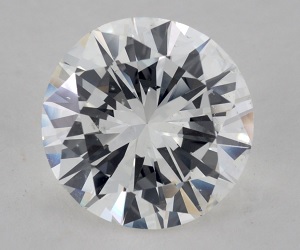
Small
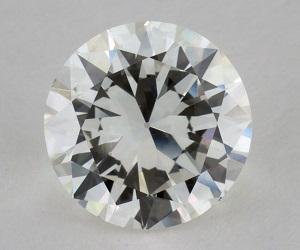
Medium
A culet size larger than small can easily be seen and often mistaken to be inclusion.
Personally, I prefer a diamond with no culet and most consumers in different markets also have the same preference. When you are reviewing a diamond grading report, I recommend sticking to those with a culet size between None (best), Very Small.
Symmetry
Symmetry basically refers to how consistent a diamond’s facets are polished to. If there are some misshapen facets, it can set off a chain effect which affects surrounding facets. Symmetry is also a measure of how precise each individual facets align in relation to each other.
A diamond with poor symmetry may misdirect light that travels through the diamond, sending it off at slightly wrong angles, and thereby reducing the diamond’s brilliance.
Here’s an interesting fact: Symmetry flaws are often created by design and not as a result of incompetent cutting skills. Most symmetry flaws are purposely introduced during the polishing process.
For example, an extra facet may be polished into the diamond’s surface to remove an inclusion in order to achieve a higher clarity grade.
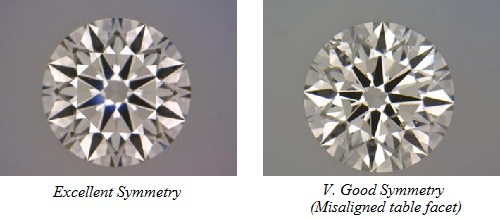
Here is a List of Common Symmetry Flaws
1. The table or culet being very slightly off-center.
2. Unequal sizes of opposing facets.
3. Misshapen facets.
4. Wavy girdles.
5. The table not being parallel to the girdle.
6. Pavilion and crown facets are out of alignment.
Since a diamond with poor symmetry may cause problems with light performance and can adversely impact the overall outline, my recommendation is to stick with a Very Good or Excellent grade for round diamonds.
Comparisons of Fancy Shapes With Different Symmetry Grades
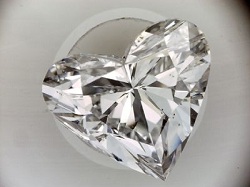
Good Symmetry

Very Good Symmetry
Can you tell the differences between the 2 stones? One of them has unequal looking lobes while the other showcases a pleasing shape.
For fancy shapes, I recommend choosing diamonds with at least a Very Good symmetry grade. Fancy cut diamonds with Good symmetry grades need to be examined on a case by case basis and shouldn’t be automatically discounted.
That said, fancy shaped diamonds are a little more tricky to select. Bear in mind you do require additional data like photographs or videos in order for you to perform critical examinations.
Polish
Polish refers to how smooth the diamond’s surface is and it is responsible for giving the diamond its sheen and luster. During the cutting process, a rough diamond is placed on a spinning turntable and each facet is added one at a time.
A high quality polish will not leave any visible marks or scratches and creates a smooth planar surface ideal for light transmission.
On the other hand, poor polish will result in a lackluster appearance due to the presence of marks that can blur the diamond’s surface. On a microscopic level, these grooved surfaces can cause undesirable diffusion of light rays and hinder optics.

Even under 10X, polish lines for a Good grading is not easily detected by the untrained eye.
With that said, there is no need to get carried away and buy only diamonds with Excellent polish ratings. In real life, the differences between a very good and excellent polish are almost undetectable to the naked eye. My recommendation is that you should not choose a diamond with a polish below Very Good.
By now, I hope you have a better idea about the various elements that contribute towards a diamond’s cut. If you have further questions, feel free to leave a comment below. On the next page, I will show you how to determine a diamond’s optics rationally and highlight insights that a certificate doesn’t tell you…
Related Articles
Leave A Comment


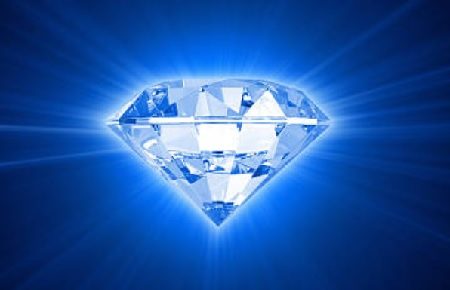
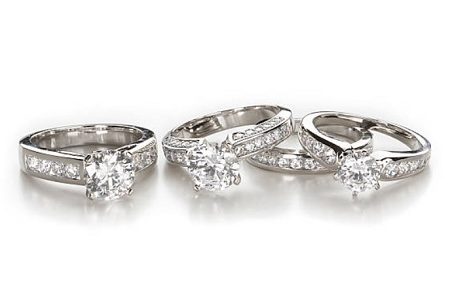
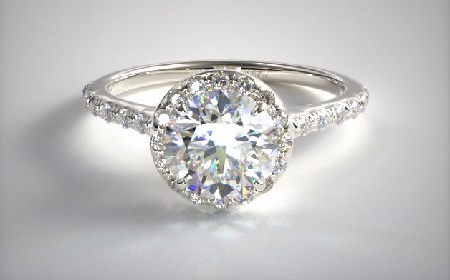









6 Comments
Cut is the factor that fuels a diamond’s fire, sparkle and brilliance. The image to the right shows how important the proper cut can be in making the diamond as brilliant as possible. If the diamond is cut too deep or too shallow, it will not reflect light back to the eye in the most optimal fashion possible and the diamond won’t have that fiery brilliance that is so sought after.
After being impressed by the depth and comprehensive knowledge base threaded into your articles on Beyond 4Cs, I realized I should email you about a diamond I have been eyeing.
Details about the diamond can be found here: https://www.whiteflash.com/loose-diamonds/princess-cut-loose-diamond-3986317.htm
It’s a 3.155ct J VS1 ACA princess cut. I would set this in a platinum solitaire with half eternity (most likely) setting. My specific concerns are the color of this diamond (J), the markings shown (cloud/feather) on the diamond report, and some of the light leakage/symmetry. The thin-medium girdle looks fine. I initially sought out to find a diamond with a color of I or better. I have some fear of the brown color showing too much in this particular diamond and/or contrasting noticeably with the diamonds in the band.
However, this diamond seems to have a substantial amount of intrinsic value to me considering its cut and weight (for what it’s worth, my budget would ideally be around $25k for the stone).
In your opinion, is this a diamond I should seriously consider buying? Or would it be a mistake to buy this diamond? If the latter, what would you prefer to see in a similar stone that would make its purchase worthwhile?
I reviewed the diamond here: https://www.whiteflash.com/loose-diamonds/princess-cut-loose-diamond-3986317.htm
The diamond is well cut for light performance and the diamond is eyeclean. Clarity is not going to be an issue for you. In terms of cut quality, princess cut diamonds do not perform the same way that round brilliants do. This is a top of the line diamond in cut quality and even so, they will exhibit minute light leakage and it is not something I would worry about. In fact, the minute amount of light leakage and greens help with scintillation patterning.
You also rightly point out the thin-medium girdle being fine. The polish and symmetry of this princess cut diamond are also rated as Ideal and it is definitely not an issue.
COLOR is likely going to be your problem. At such a large size diamond, don’t expect a J or an I to be totally white. It doesn’t happen. If you expect a diamond to be white, get a G or better color. And with that said, most readers have no issues with J or K diamonds because they don’t mind a very slight tint of color. If that affects you, you just have to fork out the premium and pony up for a G or better color or go significantly lower in carat size.
At this price point and the cut quality the diamond presents, I have no issues buying it for myself. So that should speak a lot.
Thank you so much for the feedback and insight. It’s people like you who keep my faith in a prosperous future for humanity — I truly appreciate it.
While the diamond is beautiful, I think you may be right about the color being problematic. As an alternate option, I found this diamond which although it is not as substantial in size, it may answer the color issue: https://www.whiteflash.com/loose-diamonds/princess-cut-loose-diamond-4017827.htm
Hope you’re having a great weekend.
I know everyone says cut is king! When buying a diamond. I looked at a diamond GIA certified and the cut is fair. polish is good and symmetry is fair. I looked at it in outside lighting and other lighting and it has so much sparkle. It’s an I in color eye clean si2. 4.01 ct . Should I even consider this diamond just because I like the way it looks. Also how much should a diamond with these specs cost? Or should I just keep looking. Thank you
LOL. You just haven’t seen the well cut ones in comparison. If you think a garbage tier cut quality diamond with a Fair rating looks good, wait till you see the truly well cut diamonds. It’s a day and night comparison.